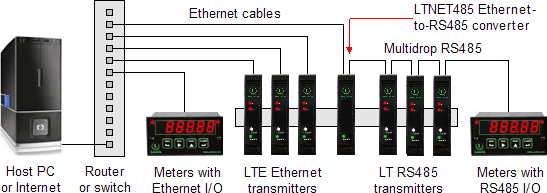
MLTE-FR | Ethernet & 4-20 mA Output | Sum, Difference, Ratio, Product of 2 Inputs | DIN Rail Transmitter
This Micron Meters transmitter accepts two independently scalable input channels A & B from a wide range of pulse sources, such as NPN or PNP proximity switches, contact closures, digital logic, magnetic pickups down to 12 mV, or AC voltages to 250 Vac. Input frequencies can range from 0.005 Hz to 1 MHz.
Arithmetic functions A+B, A-B, AxB, A/B or A/B-1 are made available by the Extended counter main board and can track the sum, difference, product, ratio, or draw of both input channels. These functions can be applied to scaled rates, scaled totals, square root of rates, totals after square root extraction, custom curve linearized rates, or totals after custom curve linearization.
- Sum can be used to add two flows for total flow, or to add the number of parts carried by two conveyor belts.
- Difference can be used to subtract outflow from inflow for net flow, or to subtract reject parts from total parts.
- Product can be used to multiply two rates, for example to compute horsepower by multiplying torque by RPM.
- Ratio can be used to compare flow rates in two channels, the RPM of rollers or gears, or the speed of moving machinery, such as conveyor belts. Ratio can also be applied to scaled totals to compare two batches to be mixed. In this application, one transmitter is used to monitor the ratio of flow rates, and a second transmitter to monitor the resulting batch totals.
- Draw is obtained by subtracting 1 from ratio. Draw is used to measure the elongation of material as it passes between rollers, or to monitor variation in the speed of rollers for tensioning.

Exceptional Accuracy and Stability. Micron pulse input frequency and rate transmitters determine frequency by taking the inverse of period as measured with a calibrated quartz crystal time base. Extremely accurate 6-digit internal readings (±999,999 counts) are processed in software.
The update rate of the transmitter output is a programmed gate time + 30 ms + 0-2 signal periods. For pulse rates of 60 Hz and above, the update rate would be 20 per second. Such fast update rates are ideal for alarm and control.
Standard features of Micron MLTE transmitters include:
- Ethernet I/O, isolated. Supported protocols are Modbus RTU and ASCII (tunneled via Modbus TCP) and Custom ASCII. The latter is simpler than the Modbus protocol and is recommended when all devices are Micron units. Note that RS232 or RS485 data I/O in lieu of Ethernet is provided by MLT Series transmitters.
- 4-20 mA, 0-20 mA or 0-10V analog transmitter output, isolated, jumper-selectable and user scalable. All selections provide 16-bit (0.0015%) resolution of output span and 0.02% output accuracy of a reading from -99,999 to +99,999 counts that is also transmitted digitally. Output isolation from signal and power grounds eliminates potential ground loop problems. The supply can drive 20 mA into a 500 ohm (or lower) load for 10V compliance, or 10V into a 5K ohm (or higher) load for 2 mA compliance
- Dual solid state relays, isolated. Available for local alarm or control. Rated 120 mA at 130 Vac or 180 Vdc.
- Universal 85-264 Vac power. Low-voltage 10-48 Vdc or 12-32 Vac power is optional.
Discovery and configuration of the Ethernet Nodes is easily achieved with the Node Manager Software, and the discovered transmitters can then be programmed using the Instrument Setup Software. Both software's run on a PC under MS Windows and can be downloaded from this website at no charge.

![]() MLTE-FR Ratio, Product, sum or Difference Transmitter | Support Library
MLTE-FR Ratio, Product, sum or Difference Transmitter | Support Library
Data Sheet | User Manual
